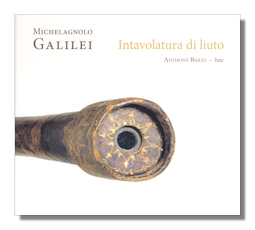
The Internet's Premier Classical Music Source
Related Links
- V Galilei Reviews
- Latest Reviews
- More Reviews
-
By Composer
-
Collections
DVD & Blu-ray
Books
Concert Reviews
Articles/Interviews
Software
Audio
Search Amazon
Recommended Links
Site News
 CD Review
CD Review
Galileo's Father and Brother

Intavolatura di liuto
- Michelagnolo Galilei:
- Sonate in fa minore
- Sonate in do maggiore
- Sonate in si bemolle maggiore
- Sonate in do minore
- Sonate in sol maggiore
- Sonate in la minore
- Toccata in re minore
- Toccata in fa maggiore
- Vincenzo Galilei:
- Calliope
- Polymnia
- Urania
- Alcun non può saper
- Fantasia Terza
Anthony Bailes, lute
Ramée RAM1306
A couple of years ago Classical Net looked at a collection of Renaissance music by the father of John Milton (Sublime Discourses - Regent REGCD341). Here is a splendid CD on the ever-enterprising Ramée label of lute music by the younger brother of the scientist, Galileo Galilei, Michelagnolo (1575-1631) and their father, Vincenzo (c.1520-1591).
Both Vincenzo and Michelagnolo were professional musicians who shone in the same way as Galileo did in science; though perhaps not to the same extent. Indeed, Michelagnolo seems to have been something of an infant prodigy. The style of his Primo libro d'intavolatura di liuto (from which this collection is taken) is influenced by his time in Munich. Typical of this are the dissonances, which Michelagnolo's preface to the collection assures us are not typographical errors (neither is the spelling of his name). Further, the quieter, looser, more relaxed and reflective mood which permeates almost the entire collection reminds us of the newly-developing French feel for the lute. Yet the use of four or five movements in dance-form is but one of the many aspects of the music which are essentially Italian.
This admixture of approaches to writing for the lute creates enhanced and broad richness, not confusion. The melodies, while being for the most part simple and transparent, are rendered in clear, linear and temperate fashion by Anthony Bailes, who specializes in such repertoire. His touch is soft yet clean. His phrasing expressive throughout. And his understanding of how the music must have sounded in 400 years ago very persuasive.
Bailes has clearly thought a great deal about the best ways to present the music on this CD. For instance Michelagnolo's pieces are interspersed with a handful of movements by his father. Bailes does not try to overplay the contrast between the two. Nor to bend the idiom to suggest similarities. The music throughout is allowed to speak for itself in all its uncomplicated, rather gentle and unassuming openness.
In particular, as he plays, each piece is assumed to be – and rendered – complete by itself. We sense that he has allowed himself (and us) all the time in the world to unfold intricacies, lingerings, meanderings and the petal-like beauty of each piece. And we quickly adapt to the gentle pace of the music… even the corrente movements such as those of the C minor sonata [tr.s 13, 14, 15] are slow. As a result nothing is hidden. Perhaps Michelagnolo Galilei was influenced by his brother's love of exposing what's really there, to reveal the truth.
This obvious affection on Bailes part for the moderate tempi of these lovely works does not obscure his ability otherwise to bring style and of course technical prowess to his performances. His lute style is immediate and respectful of the intricacies and intimate convolutions of the instrument. He never loses sight of the directions which they take, of their innate sense of purpose; nor of their subdued yet uncompromising drive.
The most pronounced side-effect of this balance between the tender, considerate and thoughtful on the one hand, and the purposeful and unobtrusively-structured on the other, is the marriage of solidity and delicacy in the sound of the lute itself. It's closely miked and, while not going so far as to lose the impact of the music by trying to make this a CD designed to showcase the lute for its own sake, this music could be played on no other instrument for Bailes. The result is a very pleasing experience indeed. On repeated listening, it's likely that the music will settle on you a greater and greater sense of satisfaction. One component of this is peace; another is that you are hearing a superb expert quietly eliciting from the strings every drop of meaning and calm delight.
The acoustic of the CD is responsive; the production emphasizes the location in which the recording was made: the Schloß Beuggen in Rheilfelden, Germany. It's resonant and the recording (on which bird song outside can be heard in quiet moments) presents the lute's subdued yet uncompromisingly lyrical tone to good advantage. Bailes plays a ten-course instrument throughout the recording. There's a richness and generosity which sets the unpretentious nature of the music off to good effect. The booklet that comes with the CD is detailed, contains a lengthy exposition of the background to, and strengths of, the music and the relevant aspects of lives of the extraordinary Galilei family. This is useful, given the relative obscurity of their relationship with the musical world. This is not music of the most profound or original nature. But it has much more than mere curiosity value. For lovers of instrumental music of the period, this is a CD well worth investigating.
Copyright © 2014, Mark Sealey





















